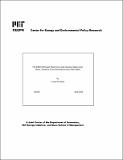| dc.contributor.author | Davis, Lucas W. | |
| dc.date.accessioned | 2009-06-29T17:52:44Z | |
| dc.date.available | 2009-06-29T17:52:44Z | |
| dc.date.issued | 2008 | |
| dc.identifier.other | 2008-009 | |
| dc.identifier.uri | http://hdl.handle.net/1721.1/45653 | |
| dc.description.abstract | Current trends in electricity consumption imply that hundreds of new fossil-fuel power plants will be built in the United States over the next several decades. Power plant siting has become increasingly contentious, in part because power plants are a source of numerous negative local externalities including elevated levels of air pollution, haze, noise and traffic. Policymakers attempt to take these local disamenities into account when siting facilities, but little reliable evidence is available about their quantitative importance. This paper examines neighborhoods in the United States where power plants were opened during the 1990s using household-level data from a restricted version of the U.S. decennial census. Compared to neighborhoods farther away,housing values and rents decreased by 3-5% between 1990 and 2000 in neighborhoods near sites. Estimates of household marginal willingness-to-pay to avoid power plants are reported separately for natural gas and other types of plants, large plants and small plants, base load plants and peaker plants, and upwind and downwind households. | en |
| dc.description.sponsorship | Massachusetts Institute of Technology. Center for Energy and Environmental Policy Research. | en |
| dc.relation.ispartofseries | MIT-CEEPR;08-009WP | |
| dc.title | The Effect of Power Plants on Local Housing Values and Rents: Evidence from Restricted Census Microdata | en |
| dc.type | Working Paper | en |
| dc.audience.educationlevel | | |
